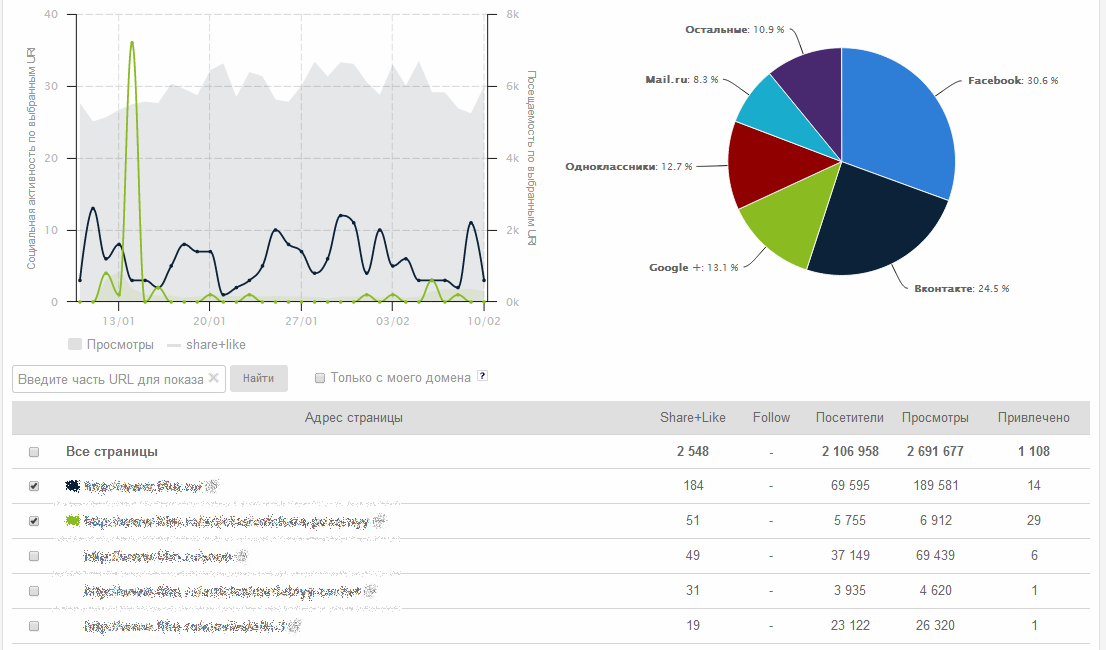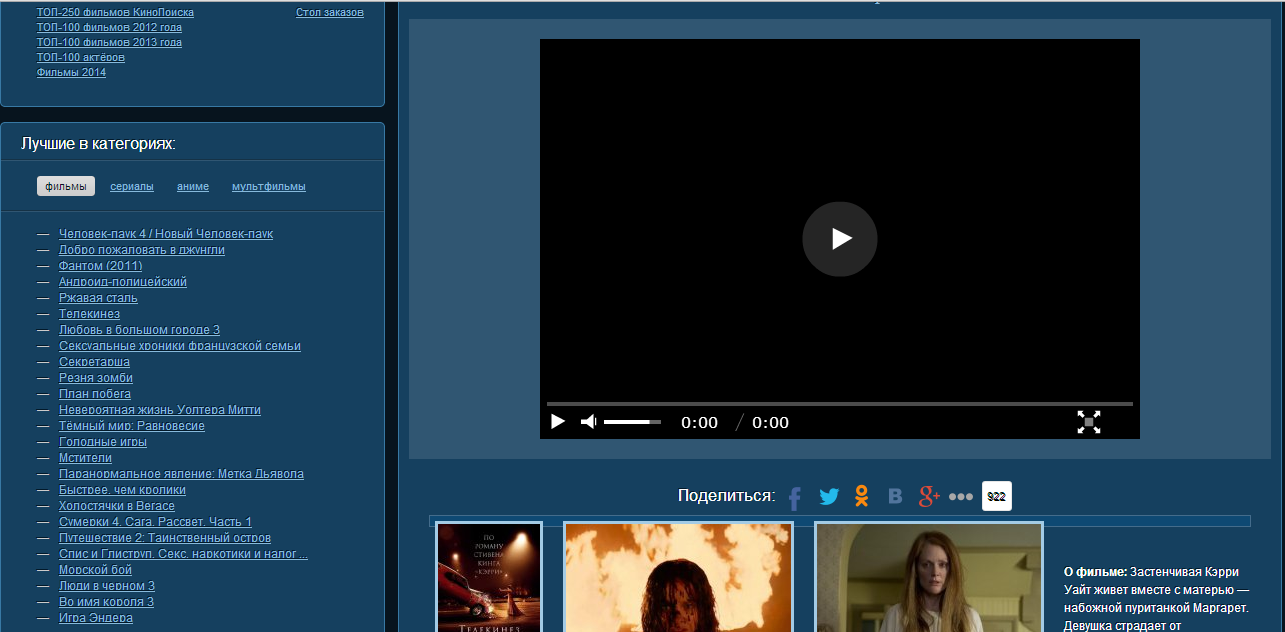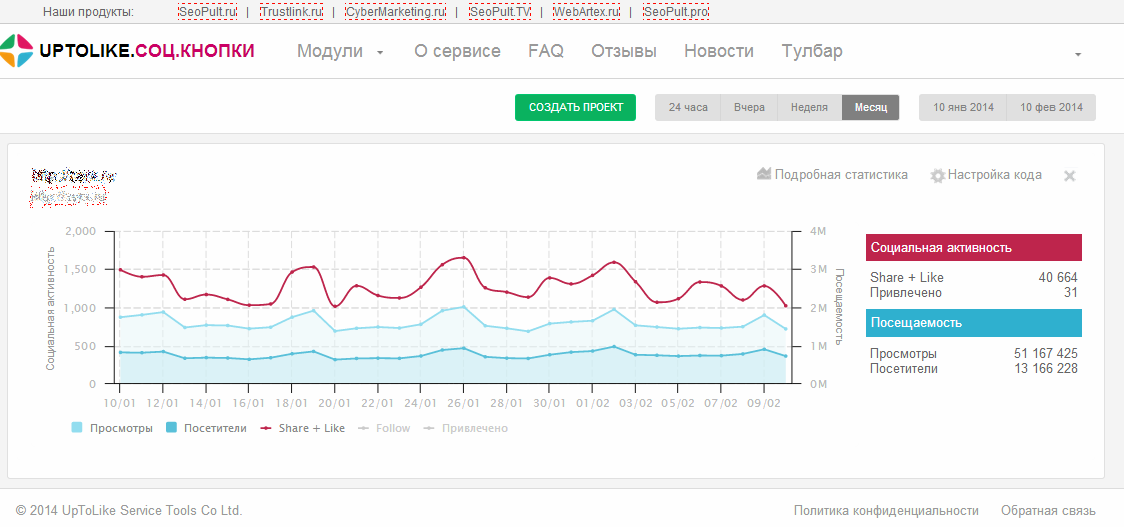Social behavior statistics on news sites: how can it help with traffic and monetization issues?
Today, when many media outlets are completely switching to electronic versions, and the audience is devoting more and more time to their friend feeds, integration with social networks and continuous growth of citation are very important for a news site. A huge role is played by social and behavioral metrics of users, which you need to know as much as possible in order to analyze and stimulate social activity. According to Awareness, Inc., about 96% of companies measure the number of fans and followers, 89% - traffic from social networks, 55% - brand references on the Internet, 55% - balloons and 51% - tone statements.
The media briefingconducted a little research to find out which news media are best integrated with social networks and get the most tweets and balls. 6 popular publications were reviewed and the number of balls and tweets of 50 publications of each of them was calculated. The results were as follows: Daily Mail - 6 526 balls and 1,545 tweets, Independent - 5 923 and 4 331, Telegraph - 3 372 and 2 419, Guardian - 2 866 and 2 818, Sun - 536 and 345, Times - 131 and 294 The latest edition takes care of maintaining a format known for decades. The rest are actively working to increase the social activity of readers, because the share of traffic from social networks is increasing every day.
In order to stimulate and analyze the social behavior of users on websites, a special multifunctional module UpToLike (developed by SeoPult) was launched at the end of 2013 . Now this system does not yet work at full capacity and not all functions are implemented, but there are several very utilitarian things and “chips” that are worth mentioning. These are subtle statistics of social behavior and complete customization of social buttons.
So, for example, the monthly statistics of Site 1 look like:

On the screen shot it is clear that over a month all the pages of the site collect more than 2,500 likes and balls, while more than 1,100 new users come to the site from social networks.
In the Detailed statistics tab you can see the following graphs:

The page layout of the site and the layout from social networks are given: it is clearly visible which pages give the most likes, balls and tweets, which pages return users, where new users come from, from which social networks.
The buttons themselves on the site look like this (and this is a very successful example of the correct location: the first screen, vertically to the left):

Here is another example of the location of the buttons: under the player showing the movie on Site 2 (perhaps not the most successful placement option, and below we will see social statistics of this site): The

statistics of Site 2 looks like this:

Compared to the huge number of likes and balls per month, the number of attracted users from social networks is not at all significant.

One of the possible reasons for this picture is that almost half of social traffic comes from Vkontakte
A few words about customization. The UpToLike buttons can be located anywhere on the page, executed in different colors, sizes, styles, shapes, 29 social networks can be involved here, as well as the functions “Print”, “Add to Favorites”, etc. In the coming days, they will be added functions of rotation and increase of buttons during hover, as well as the variability of the text for sharing “Share” (you can insert your text instead of “Share” as much as you have enough imagination).
All of these things - this is primarily:
a) a field for experimentation with conversion;
b) a simple way to "refresh" the site.
How exactly will statistics of social behavior of users help news sites?
Growth of traffic from social networks
According to a Reuters Institute study, a news site receives an average of 7.5% of referral traffic from Facebook. Moreover, in general, traffic from social networks, according to various estimates, can be up to 30%, and primarily due to sharing. Statistics of social activity on the site will help to understand which pages have the greatest social potential and which will increase citation.
Organic traffic growth
What is fundamentally important in the first place for news portals, which are just beginning to gain their share of readers. Both Yandex and Google pay increased attention to social factors when ranking resources. At the same time, the number of likes, balls, friends on social networks, non-search traffic, how much time people spend on the site, etc. are important. Many people believe that in the future, social signals can even supplant links that have long been considered the main ranking factor. Already today, sites integrated with Google+ occupy higher positions in SERP than other resources.
Monetization
Another advantage follows from the previous paragraph. Since social and behavioral factors are gaining more weight when ranking sites, they are important in building link mass. Sites integrated with social systems and receiving a consistently large number of likes and shares will be given priority by companies looking for donor resources for posting links or articles.
Hanging Content Quality and Relevance
Knowledge of social and behavioral metrics will make content as relevant as possible to the audience. By comparing the statistics of likes, balls, the number and quality of comments, the traffic received by the pages, you can understand which sections, themes, content formats, headers work best. And further adjust the content, increasing the number of shares and satisfied readers. For example, you can easily check whether the reader really is so powerfully caught by headings such as “7 ways to change life for the better,” “33 tips for hamster owners,” etc.
Increasing the conversion rate of individual page elements
The title, the length of the text, the presence of illustrations, formatting of the text - all these details affect not only whether the material will be read, but also the likelihood that he will receive a like or a ball. According to a study by The Media Briefing, Guardian texts receive more than 800 words on average more than 100 tweets, while texts up to 500 words receive no more than 10. Interestingly, the length of articles in Telegraph, Daily Mail, The Times does not affect number of tweets.
Optimal arrangement of social buttons on the site
The appearance of social buttons and their location affects the number of likes and shares that they can receive. Of course, each site is individual, and what works on one resource may not work on another. This is where the statistics of social activity will help. Many note, for example, that the dynamic panel on the left side receives much more likes and shares than other variations. In the case of Quick Sprout - 226% more. Also on news portals usually work well medium-sized, located in the field of view and easily visible buttons on the page (which will not always be effective for an online store).
In increasing the number of regular readers
According to statistics, a person who puts a like or a ball is likely to return to the site. And the more balls from one person, the greater the likelihood that he will subscribe to updates and will regularly look at the site.
The media briefingconducted a little research to find out which news media are best integrated with social networks and get the most tweets and balls. 6 popular publications were reviewed and the number of balls and tweets of 50 publications of each of them was calculated. The results were as follows: Daily Mail - 6 526 balls and 1,545 tweets, Independent - 5 923 and 4 331, Telegraph - 3 372 and 2 419, Guardian - 2 866 and 2 818, Sun - 536 and 345, Times - 131 and 294 The latest edition takes care of maintaining a format known for decades. The rest are actively working to increase the social activity of readers, because the share of traffic from social networks is increasing every day.
In order to stimulate and analyze the social behavior of users on websites, a special multifunctional module UpToLike (developed by SeoPult) was launched at the end of 2013 . Now this system does not yet work at full capacity and not all functions are implemented, but there are several very utilitarian things and “chips” that are worth mentioning. These are subtle statistics of social behavior and complete customization of social buttons.
So, for example, the monthly statistics of Site 1 look like:

On the screen shot it is clear that over a month all the pages of the site collect more than 2,500 likes and balls, while more than 1,100 new users come to the site from social networks.
In the Detailed statistics tab you can see the following graphs:

The page layout of the site and the layout from social networks are given: it is clearly visible which pages give the most likes, balls and tweets, which pages return users, where new users come from, from which social networks.
The buttons themselves on the site look like this (and this is a very successful example of the correct location: the first screen, vertically to the left):

Here is another example of the location of the buttons: under the player showing the movie on Site 2 (perhaps not the most successful placement option, and below we will see social statistics of this site): The

statistics of Site 2 looks like this:

Compared to the huge number of likes and balls per month, the number of attracted users from social networks is not at all significant.

One of the possible reasons for this picture is that almost half of social traffic comes from Vkontakte
A few words about customization. The UpToLike buttons can be located anywhere on the page, executed in different colors, sizes, styles, shapes, 29 social networks can be involved here, as well as the functions “Print”, “Add to Favorites”, etc. In the coming days, they will be added functions of rotation and increase of buttons during hover, as well as the variability of the text for sharing “Share” (you can insert your text instead of “Share” as much as you have enough imagination).
All of these things - this is primarily:
a) a field for experimentation with conversion;
b) a simple way to "refresh" the site.
How exactly will statistics of social behavior of users help news sites?
Growth of traffic from social networks
According to a Reuters Institute study, a news site receives an average of 7.5% of referral traffic from Facebook. Moreover, in general, traffic from social networks, according to various estimates, can be up to 30%, and primarily due to sharing. Statistics of social activity on the site will help to understand which pages have the greatest social potential and which will increase citation.
Organic traffic growth
What is fundamentally important in the first place for news portals, which are just beginning to gain their share of readers. Both Yandex and Google pay increased attention to social factors when ranking resources. At the same time, the number of likes, balls, friends on social networks, non-search traffic, how much time people spend on the site, etc. are important. Many people believe that in the future, social signals can even supplant links that have long been considered the main ranking factor. Already today, sites integrated with Google+ occupy higher positions in SERP than other resources.
Monetization
Another advantage follows from the previous paragraph. Since social and behavioral factors are gaining more weight when ranking sites, they are important in building link mass. Sites integrated with social systems and receiving a consistently large number of likes and shares will be given priority by companies looking for donor resources for posting links or articles.
Hanging Content Quality and Relevance
Knowledge of social and behavioral metrics will make content as relevant as possible to the audience. By comparing the statistics of likes, balls, the number and quality of comments, the traffic received by the pages, you can understand which sections, themes, content formats, headers work best. And further adjust the content, increasing the number of shares and satisfied readers. For example, you can easily check whether the reader really is so powerfully caught by headings such as “7 ways to change life for the better,” “33 tips for hamster owners,” etc.
Increasing the conversion rate of individual page elements
The title, the length of the text, the presence of illustrations, formatting of the text - all these details affect not only whether the material will be read, but also the likelihood that he will receive a like or a ball. According to a study by The Media Briefing, Guardian texts receive more than 800 words on average more than 100 tweets, while texts up to 500 words receive no more than 10. Interestingly, the length of articles in Telegraph, Daily Mail, The Times does not affect number of tweets.
Optimal arrangement of social buttons on the site
The appearance of social buttons and their location affects the number of likes and shares that they can receive. Of course, each site is individual, and what works on one resource may not work on another. This is where the statistics of social activity will help. Many note, for example, that the dynamic panel on the left side receives much more likes and shares than other variations. In the case of Quick Sprout - 226% more. Also on news portals usually work well medium-sized, located in the field of view and easily visible buttons on the page (which will not always be effective for an online store).
In increasing the number of regular readers
According to statistics, a person who puts a like or a ball is likely to return to the site. And the more balls from one person, the greater the likelihood that he will subscribe to updates and will regularly look at the site.
